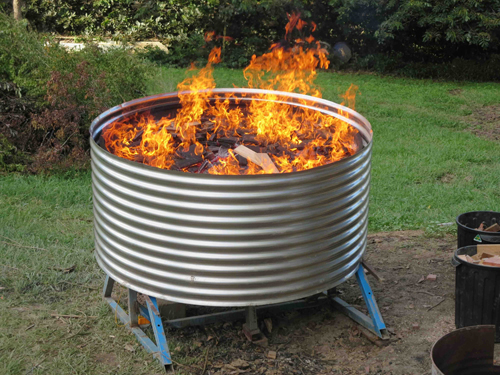Kon-Tiki Kiln: Difference between revisions
m (fixed category) |
(→Links: various link edits; link to newly uploaded file inserted) |
||
| Line 20: | Line 20: | ||
==Links== | ==Links== | ||
*[https://www.biochar-journal.org/en/ct/39 "Kon-Tiki - the democratization of biochar production" (The Biochar Jourrnal)] (read this! - internal copy [http://opensourceecology.org/wiki/File:1437139451142.pdf here]) | *[https://www.biochar-journal.org/en/ct/39 "Kon-Tiki - the democratization of biochar production" (The Biochar Jourrnal)] (read this! - internal copy [http://opensourceecology.org/wiki/File:1437139451142.pdf here]) | ||
* same as a nicely formatted paper: *[http://www.ithaka-institut.org/ithaka/media/doc/kon-tiki-presentation.pdf Ithaka Inst.: "Download the presentation of the Kon-Tiki technology" (.pdf)] | |||
*[http://opensourceecology.org/w/images/a/ad/Kon-tiki-presentation.pdf Internal copy of a presentation about this kiln] by Ithaka Institut, has many images and design specifications, complements the paper nicely [http://www.ithaka-institut.org/ithaka/media/doc/kon-tiki-presentation.pdf (original source here!)] | |||
*[http://www.ithaka-institut.org/en/ct/101 More videos from Ithaka Institut] | *[http://www.ithaka-institut.org/en/ct/101 More videos from Ithaka Institut] | ||
*[https://www.biochar-journal.org/en/ct/46 "Charmaking in the Himalayas"] (The Biochar Journal) - has picture of full-scale “flat pack” 1000 liter Kon-Tiki | *[https://www.biochar-journal.org/en/ct/46 "Charmaking in the Himalayas"] (The Biochar Journal) - has picture of full-scale “flat pack” 1000 liter Kon-Tiki | ||
*Design drawings: [http://www.thebiocharrevolution.com/blog/biochar-production-in-kon-tiki-australia-1 "Biochar Production in Kon-Tiki Australia"] | *Design drawings: [http://www.thebiocharrevolution.com/blog/biochar-production-in-kon-tiki-australia-1 "Biochar Production in Kon-Tiki Australia"] | ||
Revision as of 21:23, 28 June 2016
Excellent open source pyrolysis kiln from Switzerland for biochar production with a very clean burn. Some implements are already available and everything is open source.
Ithaka Institut writes: While most of the biochar produced during the last 5000 years was produced with open fire, modern pyrolysis suppresses the fire. The separation of the carbonisation and the flaming of the pyrolysis gases make pyrolysis technology prone to failure and expensive which is one of the reasons why the biochar technology did not have yet it's breakthrough. The Kon-Tiki flame curtain kiln re-connects biochar making to the ancient wisdom and craft of fire making and combines it with smart design based on modern thermodynamics to produce high quality char with low emissions.
Assessment
My (Rasmus) opinion: these types of open-burn kilns appear to have some advantages over those "barrel-in-a-barrel" retorts that were advocated in the past. This kiln does away with the internal metal barrier which is costly, corrodes easily and is labor-intensive to produce. The Kon-Tiki kiln can be tilted after the burn, allowing the biochar to be dumped easily for further use. The char produced with open burn kilns may be of higher quality, because volatiles and tars can evaporate more easily (a recent paper provides supporting evidence for this).
Video
Use of char in a charcoal gasifier to power an internal combustion engine
The char produced by this kiln is very clean compared to many other charcoal-making methods, i.e. it appears to have a very low content of volatiles/tars. An additional gasification step ("charcoal gasification"), would result in a very low-tar flammable gas. This gas can then power an internal combustion engine that basically requires no modifications. The sticky tars are avoided, so the internal combustion engine should be longer-lived than one run on wood gas. Obviously, no biochar is produced in this way, and all of the biomass would be used for energy.
(For more details on the discussion of woodgas vs. charcoal gasification, see Troy Martz Gasifier.)
Links
- "Kon-Tiki - the democratization of biochar production" (The Biochar Jourrnal) (read this! - internal copy here)
- same as a nicely formatted paper: *Ithaka Inst.: "Download the presentation of the Kon-Tiki technology" (.pdf)
- Internal copy of a presentation about this kiln by Ithaka Institut, has many images and design specifications, complements the paper nicely (original source here!)
- More videos from Ithaka Institut
- "Charmaking in the Himalayas" (The Biochar Journal) - has picture of full-scale “flat pack” 1000 liter Kon-Tiki
- Design drawings: "Biochar Production in Kon-Tiki Australia"
- Paper in PLOS One:"Emissions and Char Quality of Flame-Curtain "Kon Tiki" Kilns for Farmer-Scale Charcoal/Biochar Production"
